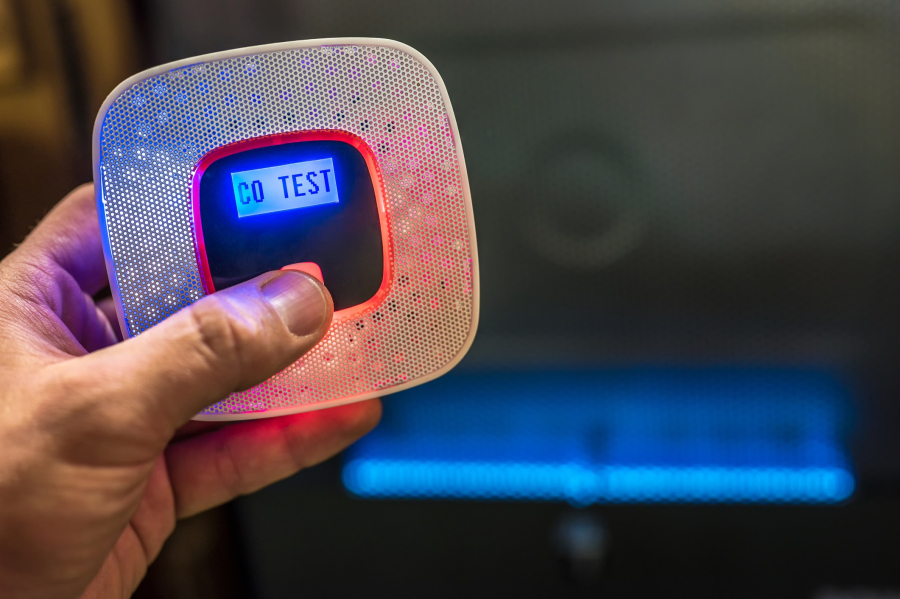
As the winter season blankets our homes with its icy embrace, it brings with it the need for warmth and comfort through various heating systems. However, lurking beneath this quest for coziness is a silent yet formidable threat - carbon monoxide (CO). Often dubbed the 'Silent Killer', carbon monoxide is an invisible, odorless gas that can emanate from heating appliances and, if left undetected, poses a severe risk to health and safety.
The relevance of carbon monoxide awareness becomes particularly critical during the cold months when we rely heavily on furnaces, boilers, and other heating systems to keep our homes warm. These systems, if not properly maintained, can become inadvertent sources of CO, making it essential to understand how to prevent, detect, and react to any potential carbon monoxide issues in your home.
Carbon Monoxide and Its Sources in Your Home
Carbon monoxide (CO) is a colourless, odorless gas that can be fatal if inhaled in large quantities. It is produced when fuels such as gas, oil, coal, or wood do not burn fully. Inside the home, heating and cooking equipment that burn fuel can be potential sources of carbon monoxide.
The danger arises because CO can accumulate to toxic levels in enclosed or poorly ventilated areas, posing a serious health risk to individuals without them even realizing it.
Why Carbon Monoxide is Dangerous
- Invisibility and Odorlessness: CO can’t be seen or smelled, making it difficult to detect without a CO detector.
- Health Risks: Exposure to CO can cause symptoms such as headaches, dizziness, weakness, nausea, and even lead to unconsciousness or death in extreme cases.
- Rapid Accumulation: CO can build up quickly in enclosed spaces, leaving little time for those exposed to react or escape.
Common Sources of Carbon Monoxide in Home Heating Systems
- Furnaces: Older or malfunctioning furnaces can produce CO, especially if they have not been regularly serviced.
- Boilers: Like furnaces, boilers that burn fuel can emit CO if they are not burning their fuel completely.
- Wood Stoves and Fireplaces: Burning wood or other materials in stoves and fireplaces can create CO, especially if they are improperly ventilated.
- Gas Heaters: Portable or older gas heaters can be a source of CO if they are not properly maintained or used in well-ventilated areas.
- Blocked Chimneys or Flues: These can prevent CO from escaping, causing it to accumulate inside the home.
Identifying Risk Factors in Heating Systems
Certain heating appliances and situations present a higher risk for carbon monoxide production. Being aware of these can help prevent potential CO hazards in your home.
- Improper Installation: Heating systems that are improperly installed can lead to incomplete combustion, producing CO.
- Lack of Regular Maintenance: Regular maintenance is crucial. Heating systems, including vents and chimneys, should be inspected and cleaned annually by a professional.
- Old or Faulty Equipment: Older appliances or those that are malfunctioning are more likely to produce CO.
- Poor Ventilation: Inadequate ventilation in areas where fuel-burning appliances are used increases the risk of CO accumulation.
- Use of Appliances for Prolonged Periods: Extended use of ovens, stoves, or heaters, especially in unventilated spaces, can lead to higher levels of CO.
Being aware of these potential hazards and ensuring your heating systems are functioning correctly are essential steps in preventing carbon monoxide poisoning in your home. Regular inspections, proper use, and adequate ventilation of heating appliances are key to maintaining a safe living environment.
Preventing Carbon Monoxide Leaks in Your Home
Ensuring the safety of your home from the threat of carbon monoxide (CO) requires vigilance and proactive measures. Preventing CO leaks is paramount, especially during the winter months when heating systems are in constant use.
By following essential safety tips and understanding the critical role of regular maintenance, homeowners can significantly reduce the risk of carbon monoxide poisoning.
Essential Safety Tips for Preventing Carbon Monoxide Leaks
- Regular Maintenance of Heating Systems: Schedule annual inspections and maintenance of your heating systems, including furnaces, boilers, water heaters, and any other fuel-burning appliances. A professional technician can identify and fix potential issues that could lead to CO leaks.
- Install and Test CO Detectors: Install carbon monoxide detectors on every level of your home, especially near bedrooms, to ensure early detection of CO. Test these detectors regularly and replace batteries at least once a year.
- Be Cautious with Fuel-Burning Appliances: Never use charcoal grills, lanterns, generators, or gasoline-powered engines inside your home, basement, garage, or near a window.
- Ensure Proper Use of Appliances: Follow the manufacturer's instructions for the safe operation of fuel-burning appliances. Never use your oven to heat your home.
- Check Vents and Flues: Regularly inspect vents and flues for blockages, leaks, or damages. This includes chimneys, which should be cleaned and inspected annually.
Proper Ventilation
Proper ventilation plays a crucial role in preventing the buildup of carbon monoxide in your home. Even with modern, efficient heating systems, adequate ventilation is necessary to ensure safe operation.
- Ventilation Systems: Ensure that your home’s ventilation systems, including exhaust fans and vents, are functioning properly and are not blocked. This includes checking for snow or debris blocking outside vents.
- Air Circulation: Regularly open windows slightly during the winter months to allow fresh air circulation, even when heating systems are in use.
- Use of Exhaust Fans: Utilize exhaust fans in your kitchen and bathroom, especially when using appliances like gas stoves, which can contribute to CO levels.
- Ventilation in Attached Garages: Be cautious with vehicles or other gasoline-powered equipment in attached garages. Even with the garage door open, CO can seep into the living areas of your home.
Preventing carbon monoxide leaks in your home involves a combination of regular maintenance, the correct use and placement of CO detectors, careful operation of fuel-burning appliances, and ensuring proper ventilation throughout your home.
These measures collectively contribute to a safer, CO-free living environment, especially during the colder months when the risk is heightened.
The Lifesaving Importance of Carbon Monoxide Detectors
In the fight against the dangers of carbon monoxide (CO) in homes, one of the most critical tools at our disposal is the carbon monoxide detector. These devices provide an essential line of defense, offering early warning of CO buildup, which can be life-saving. Their importance cannot be overstated, particularly during the winter months when heating systems are heavily used, and the risk of CO exposure increases.
Necessity of Carbon Monoxide Detectors in Homes
- Early Detection: CO detectors are designed to alert homeowners long before carbon monoxide reaches dangerous levels, providing crucial time to take action.
- Preventative Safety: In the absence of odor or color to warn us of CO presence, these detectors are the most reliable means of preventing CO poisoning.
- Legal Requirements: In many areas, installing CO detectors in homes, especially those with fuel-burning appliances or attached garages, is mandated by law.
Guidelines for the Proper Placement and Maintenance of CO Detectors
- Placement: Install CO detectors on every level of your home, including the basement. Place them near sleeping areas to ensure that the alarm will wake you up if it goes off during the night.
- Height for Installation: Unlike smoke, which rises, CO mixes with air. Therefore, detectors can be installed at any height - on the ceiling, wall, or even plugged into an outlet.
- Avoid Dead Zones: Avoid placing detectors near windows or doors where drafts could affect their operation. Also, keep them out of reach of children and away from heat sources and humidity.
- Regular Testing and Maintenance: Test your CO detectors at least once a month and replace batteries annually or as needed. Replace the entire unit according to the manufacturer's instructions, typically every 5-7 years.
Choosing the Right Carbon Monoxide Detector
When selecting a carbon monoxide detector, several features should be considered to ensure maximum protection:
- Type of Sensor: Opt for detectors with electrochemical sensors, as they are more accurate at detecting low CO levels over time.
- Battery Backup: Choose a model with a battery backup to ensure functionality during power outages.
- Digital Display: A digital display can show the exact CO levels in parts per million, which can be helpful for identifying even low levels of CO.
- End-of-Life Indicator: Look for detectors with a feature that alerts you when the unit needs to be replaced.
- Interconnectivity: Some CO detectors can be interconnected with other alarms in the home, which means when one alarm goes off, all alarms go off, ensuring you hear the alert regardless of your location in the home.
- Certification: Ensure the CO detector is certified by a recognized safety testing agency, such as Underwriters Laboratories (UL).
Investing in the right carbon monoxide detector and ensuring its proper placement and maintenance is a small yet vital step towards safeguarding your home and loved ones from the silent but deadly threat of CO.
Staying Vigilant Against Carbon Monoxide This Winter
Carbon monoxide doesn’t discriminate; it can infiltrate any home, regardless of size or location. The risk it poses – from mild symptoms like headaches and dizziness to severe consequences like unconsciousness or even death – underscores the necessity of being proactive in our approach to home heating safety.
Understanding the sources of CO, ensuring proper ventilation, and the regular maintenance of heating systems are not just recommendations; they are essential practices for a safe winter season.
The steps you take today can make a significant difference in ensuring the safety and well-being of your household. Staying vigilant against carbon monoxide is not just a seasonal responsibility; it’s a year-round commitment to safety.
This winter, let’s prioritize our health and safety by taking all necessary measures to protect against the dangers of carbon monoxide. Stay warm, stay safe, and stay informed.
